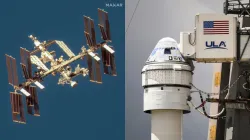Boeing Starliner to take more time for returning on Earth: NASA
Boeing's Starliner capsule’s homecoming is on hold as NASA announces the need for further technical reviews. This postponement gives engineers more time to analyze recent issues encountered by the capsule, which is currently carrying astronauts Sunita Williams and Butch Wilmore.

NASA has reportedly postponed the Boeing Starliner's return to Earth from the International Space Station with its first crew of astronauts (Sunita Williams and Butch Wilmore). The delay was caused as it allows more time for reviewing the technical issues encountered, the agency said on Friday.
By the time of writing, it did not set a new date, which has raised questions about the timing of the return of the two astronauts on Boeing's first crewed mission, which had initially been set for June 26, itself a pushback from the first potential date of June 14.
In an official statement, NASA said, "Mission managers are evaluating future return opportunities following the station’s two planned spacewalks on June 24 and July 2.”
The U.S. astronauts- Butch Wilmore and Sunita (Suni) Williams, lifted off on June 5 as a final demonstration to obtain routine flight certification from NASA.
Steve Stich, NASA's commercial crew program manager said, "We are taking our time and following our standard mission management team process.”
"Starliner is performing well in orbit while docked to the space station," Stich said, adding that the additional time would yield "valuable insight" into system upgrades for future missions.
The crewed test of the spacecraft, test-flown to space two times since 2019 without humans on board, has encountered five failures of its 28 manoeuvring thrusters, five leaks of helium gas meant to pressurize those thrusters, and a slow-moving propellant valve that signalled unfixed past issues.
The issues and the additional tests run by NASA and Boeing call into question when exactly Starliner's crew will be able to make the roughly six-hour return journey home and add to the program's broader problems.
Boeing has spent USD 1.5 billion in cost overruns beyond its USD 4.5 billion NASA development contract.
NASA wants Starliner to become the second U.S. spacecraft capable of ferrying astronauts with the ISS, alongside SpaceX's Crew Dragon, its primary ride since 2020.
But Boeing's Starliner program has battled software glitches, design problems and subcontractor disputes for years.
When Starliner arrived in the space station's vicinity to dock on June 6, the five thruster failures prevented a close approach by the spacecraft until Boeing made a fix.
It rewrote the software and tweaked some procedures to revive four of them and proceed with docking.
Starliner's undocking and return to Earth represent the spacecraft's most complicated phases of its test mission.
NASA officials have said they want to better understand the cause of the thruster failures, valve issue and helium leaks before Starliner begins its return.
While just one thruster remains dead in Starliner's current flight, Boeing encountered four thruster problems during the capsule's uncrewed return from space in 2022.
Flight rules set by Boeing and NASA require Starliner's manoeuvring thrusters to allow for "six degrees of freedom of control," at a minimum, and each has one backup thruster, a NASA spokesperson told Reuters.
That could mean at least 12 of the 28 thrusters, most of them backups, are required for a safe flight.
ALSO READ: SpaceX successfully launched its fourth test flight on June 6
ALSO READ: Indian-origin Sunita Williams' Boeing Starliner spacecraft successfully docked to ISS
Inputs from IANS